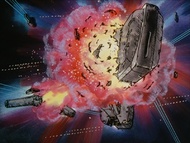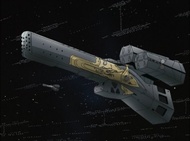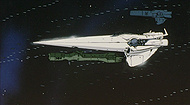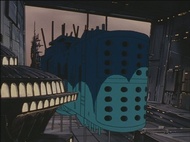Alliance–Imperial War
From Gineipaedia, the Legend of Galactic Heroes wiki
| Alliance–Imperial War | |||||
| () | |||||
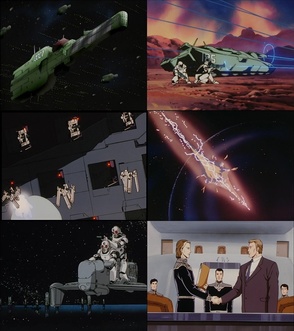 Clockwise from top left: Alliance fleet in the Second Battle of Tiamat, Alliance ground forces during the Battle of Van-Fleet, the firing of the Thor Hammer during the Seventh Battle of Iserlohn, signing ceremony of the Treaty of Ba‘alat, an Imperial ionocraft on the surface of Iserlohn Fortress at the Eighth Battle of Iserlohn, Walküre fighters launching from an Imperial battleship at the Battle of Astarte | |||||
| Date: | 14 July 640 UC (331 IC / 3440 CE) to 25 May 799 UC (1 NIC / 490 IC / 3599 CE) | ||||
| Location: | Milky Way Galaxy | ||||
| Result: | Imperial victory
| ||||
| |||||
The Alliance–Imperial War (Japanese: 銀河帝国と自由惑星同盟の戦い) was the longest, bloodiest conflict in human history, lasting nearly 160 years, from July 640 UC (331 IC / 3440 CE) to May 799 UC (1 NIC / 490 IC / 3599 CE). It began as a conflict between the autocratic Goldenbaum Dynasty and exiles who formed the democratic Free Planets Alliance on the fringes of known space. Up until its final years, the War was characterised by a number of minor skirmishes occurring in the Iserlohn Corridor, with an attempted invasion of the Alliance by the Galactic Empire every generation or so. However, the rise of the young dictator Reinhard von Lohengramm in the Empire and several major blunders on part of the Alliance government resulted in Operation Ragnarök, a successful Imperial invasion. The war ended with the Alliance surrendering to the Galactic Empire and signing an unequal peace treaty, the Treaty of Ba'alat, which essentially turned it into an Imperial client state. The Empire in turn shortly afterwards was replaced and succeeded by Lohengramm's New Galactic Empire, which completely subjugated the Alliance five months later in a second but much shorter war, uniting most of humanity.
Contents |
Background

The Galactic Federation had unified humanity following a dark age and ushered in the Golden Age of Humanity, a period of two centuries that saw great advancements in science and technology, as well as extensive galactic exploration. It was challenged by the increasing problem of space piracy, but the Galactic Federation Armada was able to defeat them, and the Federation saw many years of peace and prosperity. However, in its third century of existence, the Federation's expansion decreased drastically as the social fabric of society began to unravel. The increase in debauchery and crime led to an increase in reactionary sentiment, and allowed a young, famous admiral named Rudolf von Goldenbaum to rise to power. He became a celebrity for his successes against pirates, and thus he was easily elected into the Galactic Parliament in 296 UC (3096 CE). Rudolf established the National Reform Alliance, a right wing party that pledged to restore the country's past glories, attracting young and popular politicians while gaining more and more power.
Rudolf von Goldenbaum was elected prime minister in a referendum, and later the Parliament appointed him President as well, making him the most powerful man in the galaxy. In 308 UC (3108 CE), he declared himself "president for life" and began initiating authoritarian reforms, which included restrictions on speech. Two years later, Rudolf declared himself the first kaiser, or emperor, of the Galactic Empire, establishing the Goldenbaum Dynasty. This date became known as Year 1 of the Imperial Calendar. Kaiser Rudolf spent the next decade consolidating his power while making the new Imperial government more efficient. The reforms were effective in that regard, but civil liberties essentially became non-existent under the Kaiser's monarchic and arch-conservative regime. He also passed the infamous Inferior Genes Exclusion Act, which resulted in the deaths of millions who were deemed to be too weak and "contaminated" the human race. Eventually, the Kaiser completely disbanded the Imperial Senate (the reformed Parliament), and the high noble elite chosen by him came to control most of the wealth and territory of the fledgling Empire.
The death of Emperor Rudolf in 351 UC (42 IC / 3151 CE) was met with celebration by many people across the Empire. However, the Imperial nobility and government were well established by that point, and thus the democratic revolution that began was thoroughly suppressed by the Imperial Armed Forces. Rudolf's heir and grandson, Kaiser Sigismund I, aided by his father and Prime Minister, Joachim von Neue Stauffen, personally oversaw the quelling of the revolts. As a punishment, he stripped Imperial citizens of what few rights they had left, basically establishing serfdom. Emperor Sigismund's reign saw the consolidation of Imperial power and would guarantee its unquestioned position as the sole government of humanity for the next 150 years. It was not until more than a century after the founding of the Empire that Arle Heinessen, a serf who was sentenced to hard labour on the ice planet Altair VII, escaped from Imperial territory with some fellow exiles.
Using a giant spaceship built of dry ice that was mined on the planet, Heinessen and his followers were able to escape from the remote world and build a fleet of eighty normal vessels. The Exodus Fleet, as it came to be known, left the Imperial-controlled Orion Arm of the galaxy through the Iserlohn Corridor, a navigable area of space that led to the unexplored Sagittarius Arm. Their leader died during the journey, but his friend Nguyen Kim Hua led the republican refugees to discovering a habitable world, which they named Heinessen, in honour of their deceased leader. There, in Year 527 of the restored Universal Calendar, Nguyen Kim Hua declared the foundation of the Free Planets Alliance. (LOGH: 'Julian's Journey, Mankind's Journey')
Early stages
Battle of Dagon

The Free Planets Alliance continued to grow in secret and build up its military for the inevitable clash with the Empire. The war between the Free Planets Alliance and the Galactic Empire began in 640 UC (331 IC / 3440 CE), when the Empire first learned of the existence of the new government. The Emperor of the Galactic Empire, Kaiser Friedrich III, refused to recognise the Alliance as a legitimate state and dispatched an invasion fleet through the Iserlohn Corridor, under the command of Grand Duke Herbert, to suppress the "rebellion". The Free Planets Alliance countered with a fleet of its own, led by Vice Admiral Lin Pao, and the two forces clashed in the Dagon Starzone of the Iserlohn Corridor, on July 14 of that year. Contrary to the Kaiser's expectation, Lin Pao's fleet won an overwhelming victory over the Imperial Expeditionary Force, which was almost completely annihilated. Despite an early success, the Imperials lost the initiative as Grand Duke Herbert divided their force, eventually resulting in their encirclement. The fact that many of the Imperial commanders had no real combat experience and that the Fleet had been fighting in unknown territory were considered to be major factors for the Empire's defeat by later historians.
The Alliance quickly established a defensive line within the Iserlohn Corridor, and the war with the Empire soon escalated. The Imperial government unsuccessfully tried to suppress the news of the defeat at Dagon, which resulted in large numbers of refugees, dissidents, deserters, and criminal elements leaving the Empire for the new Alliance. Thus the population and military of the Alliance grew significantly during this time period, putting it close to the Empire's, while Lin Pao and his chief of staff Yūsuf Topparol would become celebrated heroes of the Alliance for decades to come for their victory. (LOGH: 'Julian's Journey, Mankind's Journey')
Post-Dagon actions
The battle situation remained at a stalemate for the next few decades, though the exact details of the war during this time period are unknown. However, the 24th kaiser of the Empire, Kornelias I, ended up launching a massive invasion of the Alliance in 668 UC (359 IC / 3468 CE). He wanted to both wipe the shame of the defeat at Dagon and to get out of the shadow of his predecessor, Maximilian Josef II, who was known for a number of internal reforms and was hailed as a great ruler. Kornelias therefore wanted to make his name in foreign policy. He sent emissaries first in an attempt to appear as a wise leader, asking the Alliance to surrender, but they were ignored. Thus in May 668 UC (359 IC / 3468 CE), Kornelias launched and personally commanded a military expedition against the Alliance. It was only begun after making extensive preparations in order to not repeat the mistake of Friedrich III and the Battle of Dagon. During the invasion, he became known for promoting many officers to the rank of Fleet Admiral, reaching 58 in total. Although 20 Imperial Fleet Admirals were killed in the attack, the Empire was able to beat the Alliance's counteroffensive. However, before he could completely conquer the Alliance, Kornelias was forced to withdraw due to a palace coup that occurred back on Odin, the Imperial capital. Another 15 Fleet Admirals were lost in the Alliance raids during their retreat.
The palace coup was ultimately put down, but it and the failed invasion had strained Imperial resources to the point that the Kaiser was unable to launch such an ambitious offensive again during his reign. The next known engagement did not occur until 696 UC (387 IC / 3496 CE), a battle in the Shandarua Starzone. Not much was known about this battle, other than the fact that it was an Alliance victory and was considered to be a shameful defeat for the Empire as late as 795 UC (486 IC / 3595 CE). (DIS: 'Chapter I')
Establishment of Fezzan
At some point, a second navigable route between the Galactic Empire and the Free Planets Alliance was discovered: the Fezzan Corridor. A merchant from Terra, Leopold Laap, petitioned the Imperial government with a strong passion for the autonomy of Fezzan as a special region of the Empire. As a result, in 682 UC (373 IC / 3482 CE), the Dominion of Fezzan was established as an autonomous domain of the Empire which nominally pledged loyalty to the Imperial crown, though in reality it had great control over its own policies. It was even given tacit permission to establish relations with the Alliance, with both of the other powers maintaining their own high commissioner's offices on the planet, which carried out diplomatic functions. Fezzan became an quasi-independent state, becoming a centre for three-way trade, as well as allowing diplomacy and espionage to exist between the two nations. Laap served as the first Landesherr, or feudal lord, of Fezzan. (LOGH: 'Julian's Journey, Mankind's Journey')
The Dominion possessed only a small fleet of patrol ships, instead relying on immense economic strength and political maneuvering to maintain its position. It became an economic superpower by 796 UC (487 IC / 3596 CE) and essentially controlled all trade in both the Empire and Alliance, while also maintaining considerable influence in underground criminal circles. It had been a mystery how Fezzan had become so successful economically in a short amount of time, and the true reason did not become known until after the end of the Alliance–Imperial War: it had actually been founded on the initiative of the Terraist Church, a religious cult that sought to restore Earth as the centre of humanity. The Church had used the vast wealth that had been hoarded by the United Earth Government during the Earth–Sirius War to fund the project. (LOGH: 'The Long Road Ahead')
The Terraists then allowed Fezzan to become powerful in order to use it to manipulate events from behind the scenes, preventing the Empire and Alliance from making peace and preparing for the Church's eventual takeover. It was for this reason that Fezzan was believed to have organised the murder of the 27th kaiser of the Galactic Empire, Manfred II. He narrowly avoided assassination in his youth and fled to the Free Planets Alliance, where he was raised in more liberal environment. Manfred intended to make peace upon returning to the Empire and taking the throne in 707 UC (398 IC / 3507 CE), but lasted less than a year before being assassinated, unable to carry out his plan. Reactionary nobles seemed to be responsible on the surface, but it was rumoured that Fezzan was behind the killing.
Middle stages
Rise of the 730 Mafia
The events of the first couple of decades of the new century, other than the Manfred II assassination (708 UC (399 IC / 3508 CE)), an uprising of Imperial troops under the command of Vice Admiral Telemann (717 UC (408 IC / 3517 CE)), and the Alliance victory at the Battle of Forseti (728 UC (419 IC / 3528 CE)), are largely unknown. However, the time period between 730 UC (421 IC / 3530 CE) and 745 UC (436 IC / 3545 CE) would be defined by the actions of a small group of brilliant officers in the Alliance Star Fleet: the Year 730 Mafia, named for the fact that they all graduated in that year from the Free Planets Alliance Officer Academy. The group was led by Bruce Ashbey, who came to be considered as a genius tactician, and also included Frederick Jasper, Wallace Warwick, John Drinker Cope, Vittorio di Bertini, Fang Tchewling, and Alfred Rosas. Not much is known about the first eight years of the Mafia's existence, other than the fact that they trailed each other from assignment to assignment and were led by Ashbey, who was a captain, while the others held the rank of commander. They rose to prominence in 738 UC (429 IC / 3538 CE), after defeating the Empire at the Battle of Firezard, at which point they started to become famous among the Alliance general public for their exploits. (SL: 'A Profile of Heroes', 'The Journey in Search of the Exit')
The 730 Mafia's talents and achievements attracted the attention of an Imperial defector, Admiral Martin Otto von Siegmeister, a republican idealist who became disillusioned after witnessing the flaws in the Alliance political system. He viewed the members of the 730 Mafia as his chance to bring about changes that he wanted to see. It was theorised decades later that Siegmeister used his intelligence network in the Empire to supply Ashbey with information, which he used in battles. The next several years saw the rise of the Mafia, in both their rank and popularity. Commodore Ashbey was promoted to rear admiral, and then vice admiral, being given command of one of the Alliance's numbered fleets at a young age. The other members were promoted as well, but remained one rank behind Ashbey. The man's arrogant attitude and his taking of the credit for their successes caused some resentment from the others, but the group worked together well for the most part. It was also during that time that Ashbey proposed a strategic plan for building a fortress at the Alliance end of the Iserlohn Corridor, to prevent Imperial invasions and strengthen defence. However, another project was also proposed at the time, a tactically-minded one: the enlargement of the Star Fleet. Both were costly and thus only one could be implemented. Ashbey's friend and chief of staff, Alfred Rosas, later theorised that Ashbey picked the fleet over the fortress, despite the latter being more useful over the long run, because he was a tactician rather than a strategist. (SL: 'A Short Trip to the Past')
Second Battle of Tiamat
By 745 UC (436 IC / 3545 CE), Ashbey had become a full admiral and was the Chief Commander of the Space Fleet, while his friend Rosas was the Space Fleet Chief of Staff. The others each commanded one of the Alliance's numbered fleets, and together, the 730 Mafia had reached its peak in popularity and the authority it possessed in the military. That year, Ashbey responded to an Imperial build-up of forces in the Tiamat Starzone by deploying about half of the Star Fleet there. The battle that would unfold there became the largest in the history of the war up until that point, with more than a hundred thousand ships and ten million soldiers taking part. The Imperial Forces were led by their Chief Fleet Commander himself, Fleet Admiral Zieten. Initially, the Imperials came close to encircling the 11th Fleet, under Vice Admiral John Drinker Cope, but were ultimately beaten back by reinforcements from Vice Admiral Wallace Warwick's 5th Fleet. The blow of the Alliance offensive fell on the Imperial Mückenberger Fleet, with Admiral Wilhelm von Mückenberger perishing in the early part of the fighting, due to the fact that his flagship was too far ahead of the rest of his forces. The Mückenberger Fleet was essentially annihilated and would not play a major role in the fighting, but Imperial morale remained high.
After that, Vice Admiral Warwick moved his fleet in an arc in order to cut off a wing from the main Imperial formation. It would later become known that he did this out of resentment for Ashbey taking the credit for most of their victories, and wanting some of the glory. However, the opposing Steiermark Fleet of Admiral Hauser von Steiermark was able to see through their ploy and attacked Warwick's 5th Fleet from the side, giving them considerable damage. The vice admiral then asked for reinforcements from Alliance HQ, but Ashbey decided to not reply. It was a gamble that worked: Steiermark noticed the Alliance 4th Fleet moving to counter the Imperial force performing the back-turn movement, and decided to break through Warwick's force to warn Fleet Admiral Zeiten about the development (since communications were jammed). He passed through the 5th Fleet, allowing them to rejoin the main Alliance force.
Zeiten ordered the three Imperial fleets doing the back-turn movement to withdraw to the main force upon receiving Steiermark's report. Both sides withdrew and reorganised their formations before the battle continued, with the Jasper's 4th and Warwick's 5th Fleet breaking into Imperial lines. They dealt heavy losses to Vice Admiral Keit's Fleet, who was forced to retreat. The battle remained at a stalemate for a while after that until the Empire attempted the back-turn movement again, only to be countered by the Alliance, which created a large ring-formation. Vice Admiral Kartenborn's Fleet attempted to break the stalemate by attacking the Alliance centre, but suffered heavy casualties from the 4th Fleet's counter attack, killing the Imperial commander. At that point, Ashbey and his HQ Fleet left the battle lines, disappearing from the sensors. The Imperial forces performed a successful back-turn and rear attack not long after that, with the Alliance taking losses in the Imperial onslaught, including Vice Admiral Vittorio di Bertini of the 9th Fleet.
At that moment, Ashbey's force attacked the Imperial formation in the rear, breaking through the centre and causing it to disintegrate. The Alliance fleets in front of them renewed their attack at that moment and the Imperial lines completely collapsed. The Steiermark Fleet remained the only source of organised resistance after that point and acted as rearguard as the rest of the scattered Imperial forces retreated. However, some Imperial cruisers remaining among the wreckage of destroyed warships ambushed the Hard Luck, Ashbey's flagship, causing some damage and wounding the admiral, who died in minutes. Thus ended the history of the 730 Mafia as one group. (SL: 'The Man Loved by the Goddess of Time: Chronicle of the Second Battle of Tiamat, Part I', 'The Death of a Hero: Chronicle of the Second Battle of Tiamat, Part II')
Construction of Iserlohn Fortress
The Second Battle of Tiamat was remembered as a major Alliance tactical victory. The last phase of the engagement resulted in 60 Imperial admirals being killed, and it was later said that it took a decade for the Empire to recover from the losses it sustained during those forty minutes. However, it did not gain the Alliance much in strategic terms. The death of Ashbey (who was posthumously promoted to Fleet Admiral, being the youngest then in Alliance history at the age of 36) caused the dissolution of the 730 Mafia. Its members would go on to hold prominent posts in the Star Fleet, but none of them managed to rebuild the group they had been a part of. The defeat caused the Empire to construct a large fortress in the Iserlohn Corridor, during the reign of the 35th Kaiser, Otfried V. It was completed after his death, in 766 UC (457 IC / 3566 CE), the first year of the reign of his successor, Friedrich IV. During the next couple of decades, the Alliance would attack the fortress head on six times in massive assaults, though it gained them nothing but millions of casualties. Since the construction of Iserlohn the strategic advantage was with the Empire.
Final stage
Build-up to the endgame

For most of the Alliance–Imperial War, the two sides engaged in minor skirmishes mostly limited to the Iserlohn Corridor, with an attempted invasion by the Empire about once every generation. However, beginning around 788 UC (479 IC / 3588 CE) and in the decade that followed, events began to drastically accelerate. In May 788 UC (479 IC / 3588 CE), the young Alliance junior officer Yang Wen-li, who would play a major role in later years, would first become famous during the Battle of El Facil. The planet located at the Alliance end of the Iserlohn Corridor was attacked by an Imperial force of about one thousand ships. The reacting Alliance squadron was about the same size, and no one gained the upper hand at first. The Imperial force pretended to retreat after both sides sustained around 20% casualties, then turned around and attacked the defenders from behind. It was taken by surprise and routed, with only about two hundred ships returning the El Facil. The Empire had received reinforcements and prepared to take the planet.
The Alliance commander, Rear Admiral Arthur Lynch, panicked and abandoned the planet with his top officers and remaining military ships. Yang, who had been assigned to come up with an evacuation plan for civilians earlier, was left behind, along with most of the planet's population and low-ranking troops. Yang predicted that the Empire would detect the fleeing Alliance brass and would hunt them down, giving the civilian evacuation fleet the chance to escape. His calculation proved correct, and the civilians were able to get away from the Imperials while they captured Rear Admiral Lynch, who ended up in an Imperial prison camp. Yang, meanwhile, was glorified by the Alliance media for the feat, in order to distract the public from Lynch's disgraceful act. The "Hero of El Facil" was promoted to lieutenant, and then lieutenant commander six hours later. It set a record for shortest tenure at the rank of lieutenant in Alliance history. (SL: 'The Hero of El Facil')
In 791 UC (482 IC / 3591 CE), a small patrol squadron of Imperial destroyers was ambushed in the Iserlohn Corridor by an Alliance force, which eliminated all but one of the ships. Such an occurrence was not uncommon, but it marked one of the first instances of Imperial officer Reinhard von Lohengramm (then known as von Müsel) distinguishing himself in combat. Lohengramm would go on to play a major role in the last five years of the war and its conclusion. The following year saw the fleet of Vice Admiral Michael von Keyserling attempt to ambush an Alliance force in the Arlesheim Starzone, but since some of his ships attacked prematurely, the enemy noticed them and counterattacked. The Keyserling Fleet was routed in the subsequent battle, and Keyserling would be held accountable for the shameful defeat. However, Kaiser Friedrich IV's pardon prevented him from being too severely punished. It would later be discovered that the cause of the premature attack was the addiction of some crewmen to the drug thyoxin, which was being secretly distributed by Keyserling's supply chief, Rear Admiral Christoph von Basel. Around that time, an Alliance fleet under Admiral Sidney Sithole attempted to take Iserlohn Fortress for the fifth time, using the parallel pursuit strategy. They followed the Imperial defence fleet closely back to the fortress to prevent them from firing the Thor Hammer superlaser, but the Iserlohn defence commander fired it anyway, damaging both his comrades and the approaching Alliance ships. Sithole had no choice but to withdraw. (MUT: 'Chapter II', DIS: 'Chapter I', Golden Wings)

The year 794 UC (485 IC / 3594 CE) saw the Battle of Van-Fleet, where large Alliance and Imperial fleets fought each other and ultimately did not achieve any results before withdrawing. However, Reinhard von Lohengramm took part in ground combat on Van Fleet 4-2, where Imperial forces successfully destroyed an Alliance supply base and captured the base commander. A sixth attempt to take Iserlohn also occurred that year, and ended the same way as the last ones. The most significant event of that time was the Third Battle of Tiamat, however, which happened in the early months of 795 UC (486 IC / 3595 CE). An Imperial expeditionary force was launched to commemorate the thirtieth anniversary of Kaiser Friedrich IV's ascension to the crown, in December 794 UC (485 IC / 3594 CE), and to distract the public from his lack of domestic accomplishments. News of the coming attack reached the Alliance via Fezzan, at which point it deployed three fleets (the 5th, 10th, and 11th Fleets) to counter the Imperial expeditionary force. Vice Admiral Willem Holland, the commander of the 11th Fleet, opened the battle by charging haphazardly into the flank of the Empire's formation, causing chaos but dealing considerable damage.
Imperial Vice Admiral Reinhard von Müsel was positioned at the rear of their armada by Chief Fleet Commander, Fleet Admiral Gregor von Mückenberger. He waited until the 11th Fleet reached the limits of its offensive and opened fire in a concentrated artillery barrage, which destroyed much of the fleet. The Epimetheus, Holland's flagship, was destroyed, taking the vice admiral with it. The remaining ships of the 11th Fleet were able to withdraw as the 5th and 10th Fleets came to their aid. The Alliance subsequently left the Tiamat Starzone, and the Empire also withdrew. The battle changed little other than give the Empire a propaganda victory. Müsel was promoted to the rank of full admiral for his actions during the battle, and awarded the experimental battleship Brünhild by the Kaiser. Holland was only given a single-rank posthumous promotion rather than the customary double promotion for his role in the battle. It was not until several months later that another engagement occurred: the 2nd Fleet clashed with the Müsel Fleet over the gas giant Legnica. Müsel dropped a nuclear bomb into the planet directly beneath the 2nd Fleet, causing a massive explosion that decimated the Alliance forces. (TBT: 'Part One', 'Part Two', My Conquest Is the Sea of Stars)
In September 795 UC (486 IC / 3595 CE), a fourth battle would occur at Tiamat. Undaunted by their defeat at Legnica, the Alliance amassed a large fleet in the Tiamat Starzone for another attempt to attack Iserlohn. The Imperial garrison fleet, under Fleet Admiral Gregor von Mückenberger, rushed to counter this threat, with Müsel's expeditionary group forming their left-wing. Mückenberger held the younger admiral in contempt, believing he was promoted due to the Kaiser's affection for his sister rather than for merit. He ordered Müsel's group to attack the enemy formation head-on in a diversionary measure, hoping he would be annihilated by the vastly larger Alliance fleet. However, Müsel did not open fire and passed right in front of the Alliance fleet. The gamble worked, as the enemy commanders believed he was attempting some kind of elaborate trick and did not attack his exposed flank. He was then able to get past them to the left flank of the Alliance force. The young admiral then drove into the Alliance formation and dealt it heavy casualties.
Commodore Yang Wen-li led his flagship into the Imperial fleet and positioned it directly beneath the Brünhild, taking Müsel hostage while the Alliance fleet made its escape. Müsel wanted to open fire on Yang's ship, but Karl Robert Steinmetz, his ship's captain, dissuaded him from it. Mückenberger did not want to be held accountable for causing the death of the brother of the Kaiser's favourite consort, so he did not open fire at them while they retreated. The Alliance was therefore able to withdraw, ending the battle. As a result of the battle, Müsel was awarded the title of Count Lohengramm and solidified his reputation as a skilled tactician. He was also astounded by Yang's actions and sought out the name of the commander of the ship that took him hostage, while Yang sought out the name of the commander of the white ship. This was the beginning of the rivalry that would shape galactic history over the next several years. (My Conquest Is the Sea of Stars)
Battle of Astarte
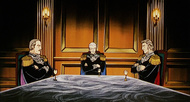
The high nobles of the Empire were outraged at the blond admiral's success and gaining the Countship of Lohengramm. The minister of state and acting Imperial prime minister, Klaus von Lichtenlade, met with the military chiefs after the battle to arrange for Lohengramm being given a new assignment. He was to be sent into Alliance territory with a fleet of 20,000 ships, but with his staff officers being transferred away from his command before the battle. Instead, he was given other "problematic" officers that high command would have liked to get rid off. Lichtenlade figured that if he lost, they would accomplish their goal of removing him, and if he won, they could make use of his growing popularity and genius. Duke Otto von Braunschweig and Baron Flegel, two of Lohengramm's biggest opponents at court, decided to leak the information to the Alliance via Adrian Rubinsky, the current Landesherr of Fezzan. The Alliance prepared to send a fleet of 40,000 ships to intercept them, divided into three groups that would envelop Lohengramm and create a repeat of the historic Battle of Dagon.
The 2nd, 4th, 6th Fleets entered the Astarte Starzone on 1 January 796 UC (487 IC / 3596 CE), intending to converge on the location of the oncoming Imperial fleet and attack it from three sides. Lohengramm saw this is a chance to destroy each of their divided fleets individually before they could meet up. He first attacked Vice Admiral Pastoll's 4th Fleet, having the numeric superiority and giving it heavy casualties. At this point, Commodore Yang Wen-li, strategic adviser to Vice Admiral Paetta, 2nd Fleet commander, recommended that they immediately go to the 6th Fleet and combine their forces. Paetta was determined to help the 4th Fleet, however, and refused to listen to him. By the time they arrived however, the 4th Fleet had been reduced to a few stragglers and Lohengramm was already engaging the 6th Fleet, destroying much of it and killing Vice Admiral Moore, its commander. Lohengramm then turned to attack the remaining 2nd Fleet, having finished off the 6th.
Yang ordered the 2nd Fleet to attack the Imperial forces at their own discretion, and after a bit of steady fighting, Lohengramm ordered his fleet to take a spindle formation to break through the enemy's lines. Yang took advantage of this: whilst the Imperial fleet broke through, the Alliance ships pretended to be routed, splitting into two groups, which then assaulted the Imperials from behind. Lohengramm was forced to turn to attack, resulting in a massive ring formation between the two fleets — like two snakes devouring each other from their tails. Unwilling to waste time and lives in a pointless battle of attrition, Lohengramm retreated from the Astarte Starzone, allowing Yang to do the same. The battle solidified Yang's reputation in the Alliance as a hero, since he was the only commander who performed effectively during the battle, and managed to prevent a total rout of the 2nd Fleet. Meanwhile, Lohengramm's reputation increased, and some of the officers under his command — particularly Admiral Willibald Joachim von Merkatz and Rear Admiral Adalbert von Fahrenheit — came to respect his genius. (Overture to a New War)
Fall of Iserlohn
The Empire's victory was short-lived, however, as Yang Wen-li succeeded in capturing the inviolable Iserlohn Fortress in May 796 UC (487 IC / 3596 CE), solidifying his reputation as a genius and popular war hero. Having been promoted to rear admiral, he was given command of a new formation, the 13th Fleet. It consisted of a mix of new recruits and survivors from the decimated 4th and 6th Fleets, and was only half the size of a regular Alliance numbered fleet. Director of Joint Operational Headquarters, Fleet Admiral Sithole, ordered Yang to take Iserlohn, with his implicit goal being increasing his own influence in the military by using Yang's victory. The young admiral agreed to do so, after some reluctance, and came up with a plan. They lured the Iserlohn Stationed Fleet out of the Fortress and later approached it, firing at the Imperial cruiser Bremen, which requested to enter Iserlohn. The fortress defence commander, Admiral Thoma von Stockhausen, allowed it to enter. The Bremen's commander, who was really Walter von Schönkopf of the Alliance's elite Rosen Ritter infantry regiment, claimed he had information to present to the fortress commander. Upon arriving at the command centre, Schönkopf took him hostage and forced the command centre crew to allow Yang's 13th Fleet to enter Iserlohn. (LOGH: 'Birth of the 13th Fleet', 'The Rosen Ritter', 'Iserlohn Captured!')
Yang then sent a message to Admiral Hans Dietrich von Seeckt, the stationed fleet commander, telling him to surrender. His staff officer, Captain Paul von Oberstein, correctly assumed that they did not have the fortress under their control yet and advised an attack. Seeckt ignored it, however, and kept his fleet at a distance to observe the situation. By that time, the Alliance completed their take-over of Iserlohn, and sent a message to Seeckt urging him retreat. He instead attacked the fortress, against Oberstein's advice, and lost 1,000 ships from the firing of the Thor Hammer. He refused to retreat and ordered his fleet to fight to the last, but Yang targeted his flagship and destroyed it. At that point the rest of the Imperials retreated. Iserlohn finally fell to the Alliance on its seventh attempt to capture it, without any significant Alliance casualties. (LOGH: 'Iserlohn Captured!')
Attempted Alliance invasion
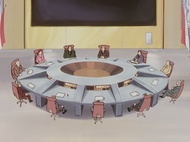
The fall of Iserlohn Fortress, which had previously been believed to be impossible and had cost the Alliance millions of lives, changed the strategic situation immensely. The Imperial War Ministry began daily meetings of the admiralty to plan for the retaking of the fortress, while the Alliance was celebrating its victory. The three military chiefs, Fleet Admirals Mückenberger, Ehrenberg, and Steinhof, wanted to resign for allowing this to happen, but Lohengramm unexpectedly did not want to take their positions and defended them in front of Kaiser Friedrich IV, who then let them remain. Yang Wen-li, the man who accomplished what was thought to be impossible with only half a fleet, became an even greater celebrity among the Alliance populace, earning the nicknames "Miracle Yang" and "Yang the Magician." He hoped that since this allowed the Alliance to prevent any potential Imperial invasion of its territory, the government would seek to sign a favourable peace treaty with the Empire, but the High Council, intoxicated with the victory, decided to do the opposite. A plan to invade the Empire that had been proposed by some young junior officers was approved in order to save the current Council's dropping approval ratings, despite the opposition of Fleet Admiral Sithole, and the High Councillors João Rebelo and Huang Rui.
It had been proposed by operations staff officer Commodore Andrew Falk, who viewed the plan as his path to a seat on the High Council, and claimed that it was a "grand offensive" to liberate the Imperial people from tyranny. He dismissed the concerns of Yang and Vice Admiral Ulanhu that its strategic goals were too vague, and that supply lines would be too long and vulnerable. In the end, the invasion would involve eight fleets, for a total of 200,000 warships and 30 million soldiers, under the overall command of Fleet Admiral Lassalle Lobos. The news of the coming invasion was leaked by Fezzani Landesherr Rubinsky to Jochen von Remscheid, the Empire's high commissioner on the planet, who quickly reported it to Odin. The Kaiser gave Count Lohengramm and his admiralty an Imperial order to counter the Alliance invasion. (LOGH: 'Invasion of the Imperial Territory')
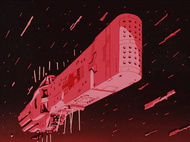
Under Lohengramm's command, the Imperial Navy took all of the food supplies of the border worlds near Iserlohn as part of a scorched earth strategy, planning on starving the invading force and causing the civilians to rise up against them. The advancing Alliance fleets met no resistance and occupied more than 200 systems. As Lohengramm expected, supplies soon began running low and unrest occurred in the occupied territories as the Alliance fleets were given orders to loot food from the local populations. The Count deployed Vice Admiral Siegfried Kircheis to destroy the Alliance supply fleet, which was lightly escorted due to the incompetence of the supreme HQ at Iserlohn, and thus preventing their expeditionary force from getting resupplied. Yang, Bewcock, and Ulanhu asked to withdraw, and Fleet Admiral Lobos — who gave Commodore Falk a lot of control and essentially became his voice — finally relented, but gave them orders to regroup in the Amritsar Starzone. At that moment, Count Lohengramm unleashed his blow. (LOGH: 'When the Rain of Grief Comes...', 'Liberation of the Frontier Zone')
As the exhausted and under-supplied Alliance fleets began to withdraw, they were hit by the fresh and well-equipped Imperial armada. The subsequent battles saw the near-annihilation of several Alliance fleets, including the 3rd Fleet, the 9th Fleet, the 10th Fleet, and the 12th Fleet. The remaining ships rallied under the overall command of Yang and Bewcock at Amritsar. In the ensuing battle, they were surrounded by the Imperial Fleet (which was led by Lohengramm himself) which went on to decimate the 8th Fleet and its commander Vice Admiral Appleton, but managed to inflict some damage on Vice Admiral Fritz Joseph Bittenfeld's Black Lancers before withdrawing. The invasion ended in disaster, with more than 20 million troops being lost (over 70% casualties). Along with greatly weakening the Alliance military and the great financial strain it placed on the already declining economy, it caused a public outrage against the government and the military establishment, with most of the High Councillors being forced to resign. The former Defence Secretary Job Trunicht became the interim council leader, since he had voted against the invasion despite arguing in favor of it before as he viewed it as a way to gain the chairman's seat. The resentment for the defeat would boil over the next year. Meanwhile, in the Empire, there was no time for victory parades as Kaiser Friedrich IV died suddenly, without a clear successor having been named. The stage was set for a year-long interlude in the war between the two nations. (LOGH: 'The Battle of Amritsar Starzone', 'New Trends')
Imperial and Alliance civil wars

The death of Emperor Friedrich began a power struggle which fundamentally changed the Empire and ultimately resulted in the end of the Goldenbaum Dynasty as a politically powerful force. Because he did not appoint a clear successor, there were a number of claimants: the teenage daughters of Duke Braunschweig and Marquis Wilhelm von Littenheim, two powerful nobles who had married Friedrich's daughters, as well as the son of the deceased Crown Prince Ludwig, the seven-year old Erwin Josef. The latter was supported by the late emperor's minister of state, Klaus von Lichtenlade, because the fact that his father was dead would make him easy to manipulate. As Count Lohengramm predicted, Lichtenlade — a civil servant with no military force of his own — came to the victorious young admiral for support. He agreed, and this Lohengramm-Lichtenlade pact led to the child being crowned as Emperor Erwin Josef II. Braunschweig and Littenheim were strongly opposed this, viewing it as a naked power grab by the cunning Lichtenlade and the ambitious upstart Reinhard von Lohengramm, correctly interpreting this move as a threat to both their power and to the dynasty. (LOGH: 'New Trends')
With the political situation in the Empire rapidly spiraling towards civil war, Lohengramm needed to keep the Alliance occupied to prevent them from interfering. He organised a prisoner of war exchange with the Alliance government using the official reason of it being a mutual amnesty to mark the ascension to the throne of the new emperor, using the swap to sneak the disgraced Rear Admiral Arthur Lynch back to his country. The commander captured at El Facil had agreed to go with Lohengramm's proposed plan to start a military coup in the Alliance, both out of desire for revenge for the Alliance government destroying his reputation and the promise of the position of Imperial Rear Admiral. He took advantage of the Alliance military's and the people's resentment for the government's deep corruption and utter ineptitude to gather a clique of dissatisfied officers, with Admiral Dwight Greenhill as their leader. Greenhill had opposed the invasion of the Empire, was no supporter of Chairman Trunicht, and had been Lobos's chief of staff. Military rebellions on worlds near the Iserlohn Corridor soon broke out, which distracted the government's attention. A coup occurred on Heinessen days later which was initially disguised as military training maneuvers, and the formation of the National Salvation Military Council (NSMC) was duly proclaimed. High-ranking officials were placed under house arrest, but Trunicht managed to escape and was hidden with help from the Terraist Church. Admiral Yang, an idealistic democrat, refused to support the coup faction and followed the government's orders to put down the rebellions. (LOGH: 'Before the Storm', 'The Yang Fleet Goes Out')

These internal developments in the Empire and Alliance led to a break in the conflict between them for roughly a year, beginning in March-April 797 UC (488 IC / 3597 CE) and lasting until the early months of 798 UC (489 IC / 3598 CE). However, the results of the two civil wars were widely different for both countries and would have a great effect on the remaining couple years of the Alliance–Imperial War. In the Empire the coalition of high noble houses that challenged the legitimacy of Emperor Erwin Josef II, the Lippstadt League, was ultimately defeated despite having a numerical superiority. Lohengramm had his noble peerage elevated to Marquis and was given all three military command offices as well as being made Imperial Fleet Supreme Commander by the Kaiser's government. He was ordered to crush the uprising. The nobles appointed High Admiral Willibald Joachim von Merkatz, a brilliant tactician and loyalist of the dynasty, to lead their combined forces. But they constantly overrode his authority and made poor decisions during the war, which brought about their defeat, and ultimately the deaths of both Duke Braunschweig and Marquis Littenheim. With the remaining aristocratic forces eventually surrendering, Lohengramm's fleets immediately returned to Odin, where Lichtenlade was rousing discontent with him now that their main rivals had been defeated. The minister of state was arrested and forced to commit suicide for allegedly planning to assassinate Lohengramm, eliminating the last barrier to absolute power for the young Imperial admiral. Perhaps the biggest loss for the Lohengramm camp and him personally was High Admiral Kircheis, who was killed by Duke Braunschweig's former chief bodyguard in a failed last ditch assassination attempt on Lohengramm. (LOGH: 'The Lippstadt Conspiracy', 'Courage and Loyalty', 'The Fall of Goldenbaum', 'Farewell, Distant Memories')
Meanwhile, in the Alliance, Admiral Yang and other loyalists were able to defeat the NSMC, but it caused the destruction of the putchists' 11th Fleet and the Artemis Necklace defence system over Heinessen. As a result, the Alliance armed forces were devastated and were seen in a negative light by the people, giving the corrupt political establishment under Trunicht (who reemerged after the coup) enough influence to override any check on his clique's power that the military may have potentially been able to provide. Gradually, the upper echelons of the military and government in the Alliance fell to Trunicht's total control, who engaged in petty rivalries with Yang, who was viewed as the biggest potential rival to Trunicht, rather than focusing on the Imperial threat. Lohengramm began internal reforms in the Empire, ending the influence of the aristocracy and the despotic rule of the Goldenbaums, as well as eliminating the corruption prevalent under the old dynasty to create an efficient government. With Lichtenlade out of the way he became both the Prime Minister and Supreme Commander of the armed forces, essentially having absolute power over the Galactic Empire, while the child Erwin Josef II remained the figurehead emperor. As Rubinsky and his advisors noted, the Empire was strengthened by its civil war which paved the way to Lohengramm's enlightened rule while the Alliance was weakened by its civil war, solidifying its trajectory to collapse under the power of the incompetent and corrupt Trunicht oligarchy. At that point Rubinsky decided to help Lohengramm unify the galaxy under his rule in order to then take over the economy and control the new empire from behind the scenes. (LOGH: 'Victory for Whose Sake?', 'First Battle')
Pre–Ragnarök developments

January 798 UC (489 IC / 3598 CE) saw the beginning of Prime Minister Lohengramm's reforms, which purged the government of corrupt elements and were aided by reformist nobles. During that time, some minor skirmishes occurred in the Iserlohn Corridor between Imperial and Alliance squadrons, but Lohengramm's focus was on domestic affairs for the first several months. However, the Fezzani autonomous government began putting forth its schemes to help the Empire conquer the Alliance at that time. They presented a plan to the Imperial military's science and technology inspector general, Admiral Anton Hilmer von Schaft, which called for installing ramjet engines onto Geiersburg Fortress and using it to attack Iserlohn. Meanwhile, Rubinsky's aide and son, Rupert Kesserling, met with Alliance high commissioner Henslow and hinted that Fezzan would only continue to provide economic aid to the Alliance if its democracy remained stable. Kesserling brought up Yang and convinced Henslow that he had ambitions on overthrowing the present administration. The diplomat reported this to Heinessen, and Job Trunicht (who was weary of Yang's massive popularity) had his Defence Secretary, Negroponte, summon the young admiral to the capital for an inquiry on his actions during last year's civil war. The Fezzani plan was to allow the Empire to take Iserlohn with Geiersburg while Yang was away. (LOGH: 'Portraits', 'One Narrow Thread')
As Lohengramm approved of Schaft's proposal and testing began on Geiersburg's warp engines, the Fezzanis began the next part of their plan. They convinced several former nobles of the old Imperial regime to take part in a new scheme. Count Jochen von Remscheid, the former Imperial high commissioner, was convinced by them to become the leader of a "legitimate" Imperial government-in-exile that would be based in the Alliance and would have Emperor Erwin Josef II, whom they would kidnap and smuggle there. Kesserling persuaded him by saying he would become the saviour of his country in helping restore the Goldenbaum Dynasty's power. Additionally, the Fezzani coerced Count Alfred von Landsberg and Captain Leopold Schumacher — veterans of the Lippstadt League who fled to Fezzan after their defeat — into being the kidnappers of the child emperor. The creation of such a Goldenbaum exile government would give Lohengramm the casus belli to invade the Alliance. Meanwhile, the Imperial attack using Geiersburg was held off by Yang's staff officers at Iserlohn long enough for Yang to return. The inquiry was abruptly ended upon receiving the news that Geiersburg Fortress was invading the Iserlohn Corridor. The attack ultimately failed, resulting in the death of the Geiersburg forces commander, Admiral Karl Gustav Kempff, and the loss of over 90% of his forces. (LOGH: 'Lost Things', 'The Return')

The inquiry was nonetheless a turning point for Yang and his colleagues, who saw it as yet another sign of the Alliance being a democracy in name only and that they could no longer ignore the threat posed by Trunicht's clan. A little while later, in July 798 UC (489 IC / 3598 CE), Landsberg and Schumacher arrived on Odin with the intent of kidnapping the Kaiser. The Imperial Military Police noted their arrival and reported it to Prime Minister von Lohengramm, who deduced what they planned to do and who was really behind it. After some talks with Nicholas Boltik, Fezzan's High Commissioner on Odin, in which the diplomat described the essence of Rubinsky's plan to him, Lohengramm permitted it to go ahead. The Imperial dictator decided to use Fezzan as a tool to further his own aims, namely conquering the Alliance. At their meeting Lohengramm also told Boltik about the possibility of using the Fezzan Corridor as an invasion route. Afterward, he did nothing to boost the security at Neue Sanssouci, the Imperial palace. Thus the two former Lippstadt officers were successful in kidnapping the young Kaiser and took him to the Alliance with a smuggler hired by the Fezzanis. The following month, Count Remscheid proclaimed the creation of the "Galactic Empire Legitimate Government," with the stated goal of restoring the old order and toppling Lohengramm's regime. High Admiral Merkatz, who went into exile in the Alliance and served on Yang's staff after the Lippstadt War, was appointed as the exiled government's military affairs minister. Lohengramm responded to the high nobles with a speech in which he condemned their actions, effectively declaring war on the Alliance. (LOGH: 'Thunder', 'The Abduction of the Young Emperor', 'The Arrow Is Released')
Operation Ragnarök
After the kidnapping, on 20 September 798 UC (489 IC / 3598 CE), the eight-month old Katharin Kätchen was proclaimed the 38th sovereign of the Galactic Empire, becoming the first Kaiserin of the Goldenbaum Dynasty. She would also be its last ruler. Meanwhile, Lohengramm met with his admirals and proposed his plan to attack the Alliance by passing through the Fezzan Corridor, annexing the autonomous territory completely, while sending a fleet to Iserlohn to trick the Alliance government. The Fezzani high commissioner in the Empire and Rubinsky's former aide, Nicholas Boltik, agreed to assist the Imperials with their takeover in exchange for being made the interim governor-general of Fezzan. Duke Lohengramm did not expect that Boltik would be able to contain Fezzani resistance, at which point the Imperial government would put the planet under its direct control. In the Alliance, Admiral Yang expected such a plan and had his adopted son Julian Mintz deliver a letter describing the details of it to Admiral Bewcock, who had been appointed Space Fleet Chief Commander. There were old contingency plans to counter an Imperial invasion through the Fezzan Corridor, but they were outdated and the Alliance did not have the fleet strength to implement them due to the severe losses sustained over the past few years. However, Trunicht and the High Council ignored Yang's and Bewcock's concerns, falsely believing that the Empire would only attack through the Iserlohn Corridor, where the Alliance's greatest commander was stationed. (LOGH: 'Operation: Ragnarök', 'Invitation to a Requiem')
Duke von Lohengramm, for his part, made sure to reinforce this delusion among Alliance politicians. In October and November of 798 UC (489 IC / 3598 CE), a force of 36,000 ships under the command of High Admiral Oskar von Reuenthal laid siege to Iserlohn Fortress, but this was a feint. In December, the bulk of the Imperial Fleet under High Admiral Wolfgang Mittermeyer invaded the Fezzan Corridor and occupied the planet. The Imperial forces were able to occupy the key targets, including the Fezzan Space Navigation Bureau that contained maps of Alliance space, but were unable to detain two notable figures: Adrian Rubinsky, the Fezzani Landesherr, and Henslow, the Alliance High Commissioner. Still, with the occupation of Fezzan the Imperial Fleet's vanguard led by Mittermeyer crossed the border into Alliance territory. In January 799 UC (1 NIC / 490 IC / 3599 CE), upon learning of this, the Alliance government assigned Admiral Bewcock the role of overseeing the defence of the homeland, since Yang was besieged at Iserlohn. Admiral Yang evacuated and abandoned the fortress on 9 January, allowing it to be retaken by Reuenthal's forces. The first major battle of the campaign, the Battle of Rantemario, occurred in February between the depleted Alliance fleet scrambled together for Bewcock to command and the advancing Imperial expeditionary forces, ending with a predictable Imperial victory. However, part of the Alliance Fleet was able to escape and avoid complete annihilation because of Yang's timely arrival and raids on the Imperial Fleet. (LOGH: 'The Sounding of Gjallarhorn', 'Fezzan Occupied', 'The Cold Spell Arrives', 'The Two-Headed Snake: The Battle of Rantemario')

Shortly after that Yang was promoted to Fleet Admiral, becoming the youngest person to hold the rank in Alliance history. Now with the Alliance government finally committed to listening to his advice, Yang and Defence Secretary Islands agreed on his plan to lure out Lohengramm by raiding his supply lines in order to kill him in a decisive battle, hoping that this would start a succession crisis and the remaining Imperial admirals would return to the Empire to determine a new leader. After a supply group was destroyed, three of Lohengramm's admirals were sent to engage Yang but ended up being defeated by Yang in small guerrilla battles, at which point the Imperial Prime Minister and Supreme Commander decided to face Yang himself. His plan called for the other admirals to take their fleets and leave him alone in the Vermilion Starzone, then return when Yang attacked and defeat him with their superior numbers. However, Lohengramm ended up being tactically defeated by Yang and the other admirals were too far away to make it in time. His secretary, Hildegard von Mariendorf, met up with Mittermeyer and Reuenthal on her own accord, convinced that Lohengramm could not defeat Yang, and urged them to go to Heinessen and make the Alliance government order Yang to stop fighting. The plan worked. The Imperial Fleet occupied the undefended Alliance capital, and Chairman Job Trunicht decided to surrender to save his own life. Yang came close to defeating Lohengramm at Vermilion, but obeyed the ceasefire order that came from Trunicht's government on principle, despite pressure from his subordinates to continue fighting. (LOGH: 'The Darkness Before Dawn', 'Battle After Battle', 'The Battle of Vermilion (Part One)', 'The Battle of Vermilion (Part Two)', 'Sudden Change')
With the end of the Battle of Vermilion and the fall of Heinessen in May 799 UC (1 NIC / 490 IC / 3599 CE), the Alliance government was forced to surrender to the Empire, ending the war. (LOGH: 'Long Live the Emperor!')
Aftermath
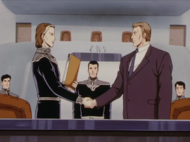
The war lasted for a total of 159 years and resulted in tens of millions, if not hundreds of millions, of deaths on both sides, being the bloodiest conflict in human history. It greatly changed the political landscape of the galaxy, ultimately leading to the collapse of the three major powers: the Goldenbaum Dynasty, the Free Planets Alliance, and the Dominion of Fezzan. The period of peace lasted for about half a year before a brief second war between the Empire and Alliance resulted in the unification of most of humanity under the New Galactic Empire.

With the surrender of the Alliance government, Supreme Council Chairman Job Trunicht signed the unequal Treaty of Ba'alat on 25 May 799 UC (1 NIC / 490 IC / 3599 CE), which ended the war and included a number of terms that essentially turned the Alliance into an Imperial client state; officially making it an autonomous part of the Galactic Empire. The treaty required the Alliance to dismantle its battleships and carriers as well as grant free access to Alliance territories to the Imperial Forces. An Imperial consul was also stationed on Heinessen as the Kaiser's representative in ensuring that the conditions were carried out. This caused the outrage of many Alliance citizens, but their anger was directed at Trunicht for surrendering and not letting Yang eliminate Reinhard. Meanwhile, Admiral Yang sent some of his subordinates, led by the defected Imperial High Admiral Merkatz, to a secret asteroid supply base to serve as an underground resistance group. This group, and other dissatisfied Alliance citizens, would later take part in a series of events the next year that resulted in the Second Alliance–Imperial War, which saw the greatly weakened Alliance completely annexed into the New Empire.
In the Empire, Duke Jürgen Offer von Pegnitz, the imperial regent of the eight-month old Catherine, signed a letter of abdication on her behalf on 20 June 799 UC (1 NIC / 490 IC / 3599 CE), formally ending nearly five centuries of rule by the Goldenbaum Dynasty. Reinhard von Lohengramm crowned himself as the new kaiser on 22 June, with the support of the majority of the Imperial people, beginning the new Goldenlöwe Dynasty and creating the New Galactic Empire. With the war against the foreign threat over, he went about focusing on extensive internal reforms. However, the end of the war also meant that the Terraist Church began its plans to bring the galaxy under its control, which would result in several assassination attempts on Reinhard's life. (LOGH: 'Long Live the Emperor!')

